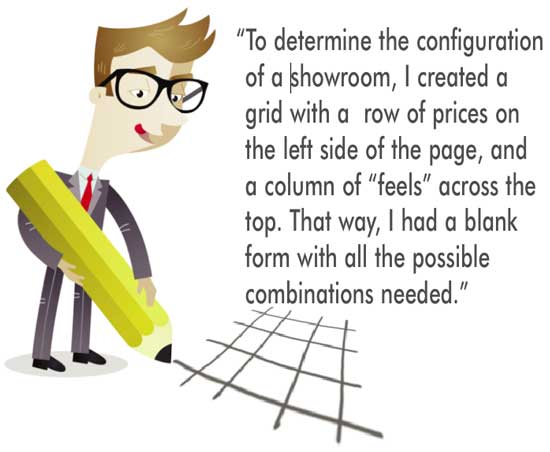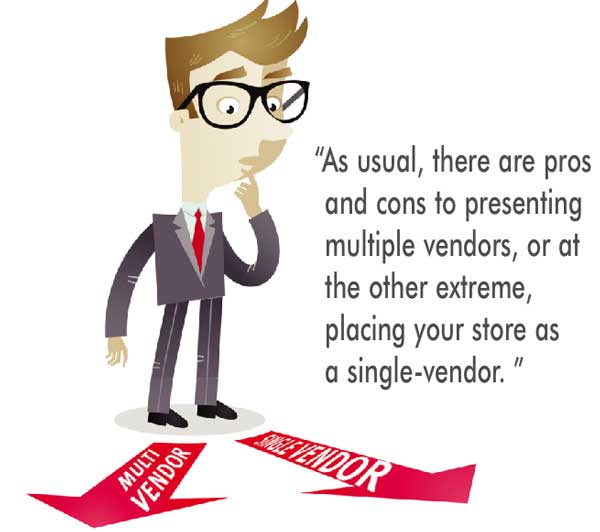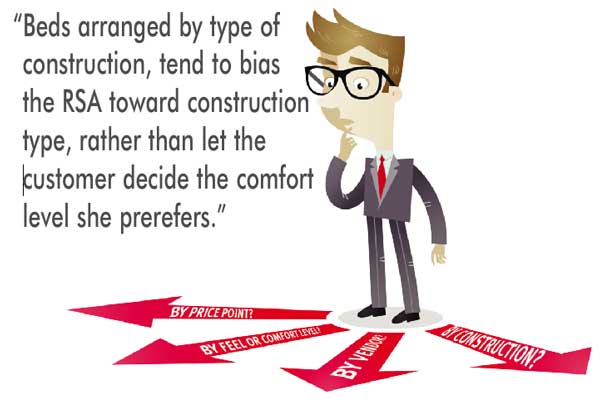Do you ever lose sales to the competition? Who doesn’t, you might ask? More specifically, do you ever lose sales because of your showroom? And even more specifically, do you lose sales because you don’t show enough beds, or show the wrong beds, or show beds the customer does not want to buy?

In this installment in the Better Bedding and Mattress Sales series, we discuss a lot of ideas on merchandising your mattress showroom, you may find useful.
How you set up your showroom depends on a lot of factors, some of which are:
- How much space do you have available?
- How serious a player are you in your local mattress market?
- How much investment do you have available for your mattress showroom?
HOW MUCH SPACE?
Space, or lack of it, is often the number one constraint facing a store owner in developing a mattress gallery. Over the past few years, the big stores and mattress chains have gotten a lot fancier in showing their mattresses. This has almost reached the point where the “presentation” seems to take on more importance than the merchandise. Of course, manufacturers continue to outdo each other in making pretty mattresses, so it is felt by some that the showroom ambience should match the elegance of the product they are selling. This evolution of presentation has naturally increased the size, in sheer square footage, of the up-scale mattress gallery. Where mattress galleries were once tightly packed with merchandise, now open spaces prevail with tastefully marked walkways. This type of presentation, of course, takes a lot more space. Some store owners, feeling intimidated by the “big mattress chain” showroom layout, worry about the dilemma of not looking as good as the fancy chain stores.
The real question is, what does the elegantly appointed chain store showroom speak to the customer?
The first thing that pops into my mind is “High Prices.” Somebody has to pay for that beautiful showroom with all the “wasted” space, and guess who it is?
So, the amount of space you need depends a lot on how you want to look. To be a serious “player” in an increasingly saturated and difficult market, anything less than 3000 square feet will compromise your merchandise selection. As we all know, landlords and tax assessors charge you by the square foot, so the bigger the space, the more money you will pay. Some of the national chains are devoting 6000 or more square feet, and some highly publicized stores seem to have no upper limit to the size of their showrooms.
Therefore, the amount of space devoted to your mattress/bedding gallery depends a lot on the image you want to present, but anything under the above mentioned 3K square foot mark, and you may not be perceived by the customer (or manufacturers) as a serious retailer.
HOW MANY VENDORS?
This is a tricky question. Vendors (manufacturers) are a jealous lot. They want to be the only one on your floor, and they only grudgingly relent to other “inferior” vendors being placed beside their products. As usual, there are pros and cons to presenting multiple vendors, or at the other extreme, positioning your store as a single-vendor. As a single vendor store, you should get a lot more attention and support from your vendor than if that vendor was just one of many competing for space. The advantages of carrying multiple vendors are: you can offer a better variety to your customer, increase the competition between your vendors, and gives your store the appearance of being a more diverse competitor. Beware of the danger of too many vendors, however. Unless you have a very high volume store, the low volume vendors will quickly become disgruntled with your performance and the resulting consequences could be unpleasant.
HOW MANY MODELS?
Before the surge in popularity of specialty bedding about ten years ago, the prevailing theory was that a showroom needed 36 to 37 models, at minimum, to cover all the important price/feel combinations. Today, that has changed. Before I offer a new number, we need to consider all the different kinds of beds that have become available in recent years, and their importance in the lineup of a serious mattress player.
In addition to the traditional innerspring sets, we now have specialty beds, which include memory foam, latex, airbeds, and then of course, hybrid beds, gels, and so on. All these innovations keep retailers scrambling to stay up with the latest thing, and not to fall short in the face of the competition.
To determine the showroom configuration, I suggest creating a grid with a row of prices on the left side of the page, and a column of “feels” across the top . That way, there is a blank form with all the possible combinations needed. By “filling in the blanks,” this method ensures that you don’t omit an important placement on the floor. Now, to the top column, the merchandiser needs to also add specialty models, and their “feels”. In past years, most specialty models were in a much higher price category, but as promotional mattress companies have gotten in on the act, there seems to be no bottom for prices in the specialty bed category.
You might ask the question, “Why do I need all these beds?” My answer is, you only need them if you want to make sales. With the rapidly expanding diversity in the mattress market, somebody in your town will have the beds you decided not to carry. They will get the sale, and they should.
I always felt, as a retailer specializing in mattresses, especially in a modest sized market, that I needed to have at least one example of everything the market had to offer. This meant carrying, on my floor, every price/feel combination and every construction type; also, all price ranges from the cheapest twin to the fanciest, most expensive, luxurious king set. Note, I make this statement within reason. There are some very expensive European imports and their American counterparts that the careful store owner, especially in a small market, might want to admire from a distance, before spending a fortune to have that set collect dust on the floor. But, that is up to the store owner, of course. For a mattress specialist in a major market area, this may be a different story.

ARRANGING YOUR FLOOR
This subject is big enough to consume an entire article, if not a small book. There are several formats by which to set up and arrange your showroom floor. Among them are:
- By price point.
- By “feel” or comfort level.
- By vendor.
- By construction type of bed; for example: all specialty beds in one area, all innersprings in another area, all hybrid beds in a different area, and so on.
My personal preference is to arrange all models in the following format: “Feels within Price Point.” This means arranging the floor by price point, in ascending or descending sequence, depending on your preference, from the front door to the back of the store or gallery. Then, all the beds representing every “feel” or comfort level, or vendor, or construction type with similar price points are displayed in the same area. For example, all $799 queens, hard or soft, or memory foam, etc., are displayed together. Beds arranged by type of construction, tend to bias retail sales associates toward construction-type, rather than letting customers decide the comfort levels they prefer. Displaying by price point and feel gives them all the available choices within a price point comfort zone, right in the same general area, without having to bounce around all over the showroom to find the right bed.
When you set up your showroom, where do you place the promotional beds, the mid-priced beds and the super-premium beds? I have observed that a lot of stores place the super-premium beds to the front near the entrance, with the cheaper, more promotional beds toward the back. This placement is more a matter of choice, I think, than anything else. The advantage of having the premium beds on display as the customer walks in the door is, of course, that it makes the showroom look better. There are a couple of downsides. If price tags are easily visible, the customer could spot the high prices and turn away in shock, exiting the store before a speedy RSA can greet them. Another disadvantage of this arrangement, and I’ve heard of this happening, is that in a neighborhood that has a sizeable itinerant population, one of these individuals might pop in and make himself at home on a $10,000 king set.
ABOUT SIZES
In what size should you display your floor models? This, again, depends a lot on how much space you have available. In my opinion, any set with a price of $499 or above should be displayed in at least a queen size. Some studies show the most popular price range is still $399 - $699 for a queen set. If this is true in your store, it is probably wise to also display the $399 sets in queen size. Anything below this price can probably be safely displayed in full or twin without danger of losing sales. This being said, however, if you have an abundance of space, even promotional products look better when displayed in queen or full. You may be saying, “But, I don’t want to sell promotional products!” Well, yes you do, unless you promote your store as a “high end, top of the line, super quality only” establishment.
Many customers still buy promotional beds, for their own reasons, not yours, no matter how good a salesperson you are.
The customer should be able to see every industry-standard size bed somewhere on your floor. These include twin, extra long twin, full, queen, king and even California king. (Reverse these last two if your business is in the state of California.) It is a good idea, I think, somewhere on your floor, to display a queen set next to a full set, so the customer has a clear idea of the difference in the two sizes. Because of the large size of the showroom, many customers will lose perspective and insist that the queen you are showing looks like a full size to them. Promotional sets most frequently sold in twin size mattresses only or sets, should be shown in twin size. Full size floor models should be kept at a minimum, unless space demands otherwise. When you sell off your floor models, queen sizes, being the better seller, are much easier to dispose of.
FOUNDATIONS
Every mattress set with a price point above $499, if the mattress is compatible (meaning it will bend properly,) should be displayed with an adjustable base. Some will argue that this price is too low to try to “attach” an adjustable base, but my experience suggests that you have a better chance of attaching, or even better, upgrading the whole sale, if you show adjustable bases with any set that might be placed in a master bed room. Again, you may be saying, “Adjustable bases are expensive to ‘floor’, and awkward to set up and handle!” You are, of course, correct in saying that. But, they are also very profitable. Any set that is displayed on an adjustable base has a much better chance of “attaching” than if it is displayed on a standard foundation. With an adjustable base under every premium mattress, the RSA can incorporate an adjustable bed presentation with just about every mattress presentation.
The proliferation of manufacturers and models of adjustable bases gives the store owner an almost unlimited selection. At minimum, I would suggest at least a good, better, and best sales story. “Best” should be the top of the line with all features and benefits that can be built into an adjustable base.

WHAT ABOUT BED FRAMES?
An often overlooked, but extremely important question to ask when setting up your showroom is the question, “Which bed frame should I put under this bed?” Of course, if you put an adjustable base with every floor model, this is no longer an issue. For those floor models displayed with standard foundations, however, let me make a suggestion. Place all floor models on premium frames, period. Premium frames are stronger, better, last longer and should be promoted for ALL beds, not just master bed rooms. Floor models get a lot of use and abuse; and a mattress set sitting on a promotional frame will sooner or later crash or squeak at the wrong time and embarrass the RSA or store owner. Don’t let this happen to you.
BOOTS AND DISPLAYS
Trying out a mattress should be easy for the customer. This means providing ample space between mattresses so the customer doesn’t have to climb over anything. Pillow floor models should be available. Don’t forget, you want to sell pillows, too. I like to see temporary, or throw-away pillow covers given to every customer. They keep your pillow models clean and most customers do not like to put their head on a pillow that thousands of other heads have touched. Most manufacturers now provide “boots,” the wraparound cover at the foot of the bed. These help keep the ticking neat and clean, and they enhance the appearance of the bed and the store. Price tags, I think, should be made to look as clean as possible whether attached to the tape edge or placed in the slot in the “boot.”
I also like to see educational posters on the wall, maybe at the back of the store, where they don’t cheapen the look of the store. Some posters with technical information, such as comparative sizes, coil types and counts can be useful to RSAs in making sales.
ADD-ONS
Part of setting up any showroom is the display and promotion of add-on items such as pillows, mattress protectors, sheets, frames, headboards and footboards, etc. How and where do you display these items?
Unless you have space to waste, it is probably not a good idea to display too much bedroom furniture in your mattress gallery. Integrating the mattress gallery with a lot of bedroom furniture, in vignettes, probably will sell more bedroom furniture, but it is possible to disrupt a smooth mattress sales process with too much furniture cluttering up the area.
Pillows, mattress protectors and sheets have become very important add-ons in the last several years. My suggestion is this: have a good selection, keep plenty of back-up, and make sure the display and inventory are far away from the exit door, near the sales desk, so they don’t walk out un-noticed on a busy day.
Don’t ignore bed frames. It is particularly important to upgrade the customer to the best frame possible. The mattress will perform better, the customer will be happier, and the store will have fewer complaints about problems that originate with a cheap frame. I strongly suggest a frame display with good, better and best cutaways and well trained RSAs who know how to explain the benefits of a premium bed frame.
OLD FLOOR MODELS
For goodness sakes, don’t keep floor models on display until they look like garage sale rejects. In a busy showroom, floor displays can become shopworn quickly. I suggest selling them off the minute they look anything less than brand-new. Customers are always looking for deals, and a neat and clean floor model makes a customer who is looking for a discount, very happy. I know the manufacturer will not give you a floor model discount every time you replace a floor model, but your showroom will certainly thank you for it.
YOUR FLOOR LAYOUT
How do you know if your layout is working for you? This is a difficult question to answer. There is an old theory in retail that says eighty percent of your business will come from twenty percent of your merchandise. It is smart to stay on top of your sales, not only in each category, and price point, but also by every model on the floor. If a SKU is not selling, or is moving slowly, there is a reason for it. Either the customers don’t like it, or the RSAs don’t like it, or possibly both. In your sales meetings, discuss slow movers as well as fast movers. Find out why the slow stuff isn’t selling. When you find a better SKU to fill that spot, sell off the slow mover and replace it.
SUMMARY
Your showroom is the most important part of your business. It IS your business. Do not neglect it. The owner or manager should do a critical walk-thru of the showroom every day. Look for anything out of place and anything that is missing. Check for dusty headboards, seedy looking covers, displaced boots and pillows; anything that degrades the order and beauty of the showplace. Look especially for liability hazards that can pop up unexpectedly. Evaluate the performance of every SKU. Stay on top of it. To neglect your showroom is to neglect your business.